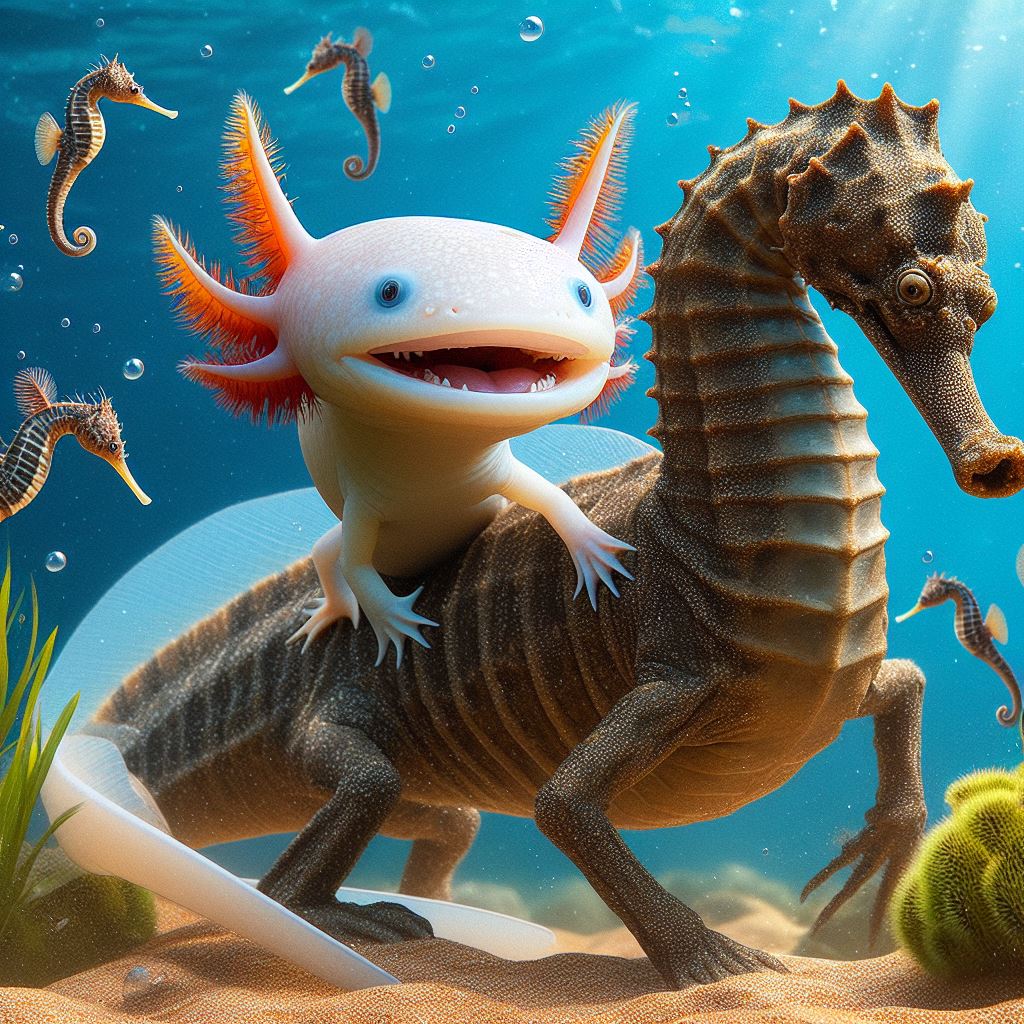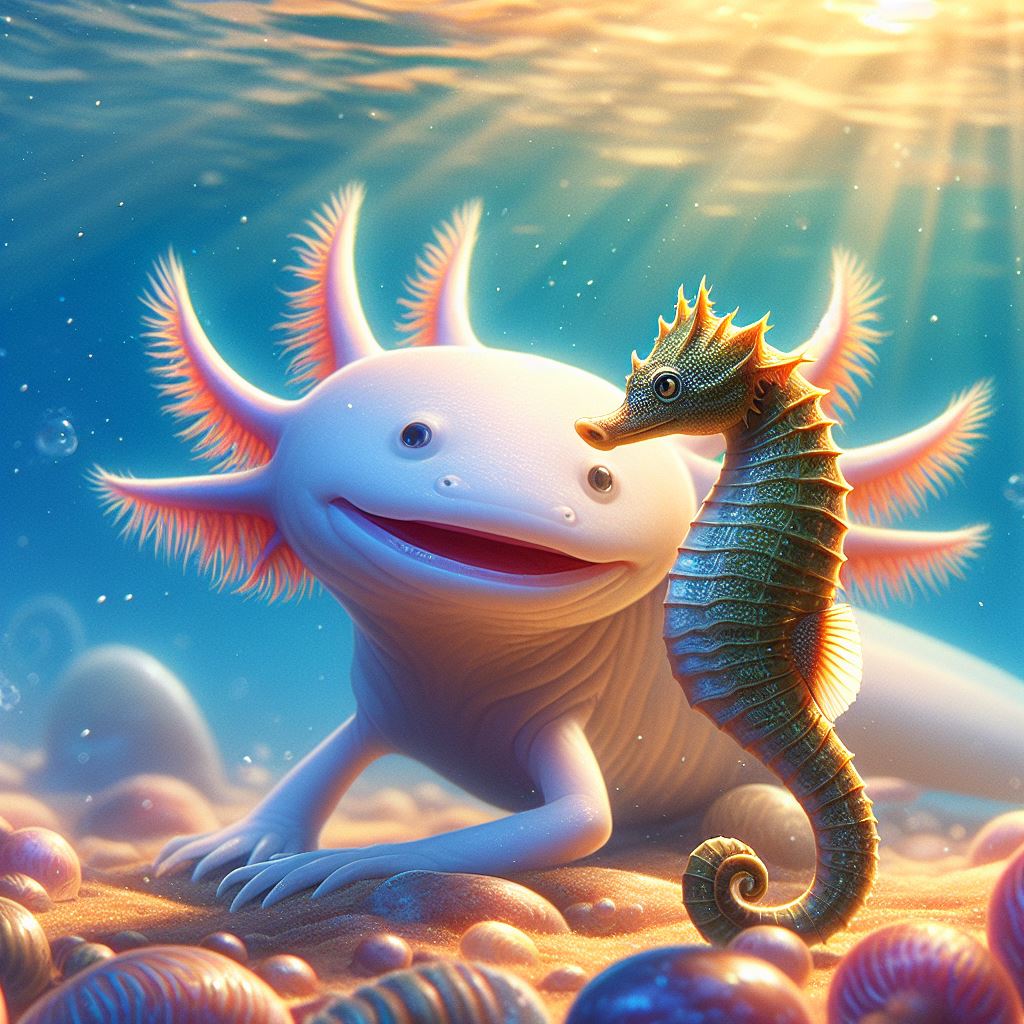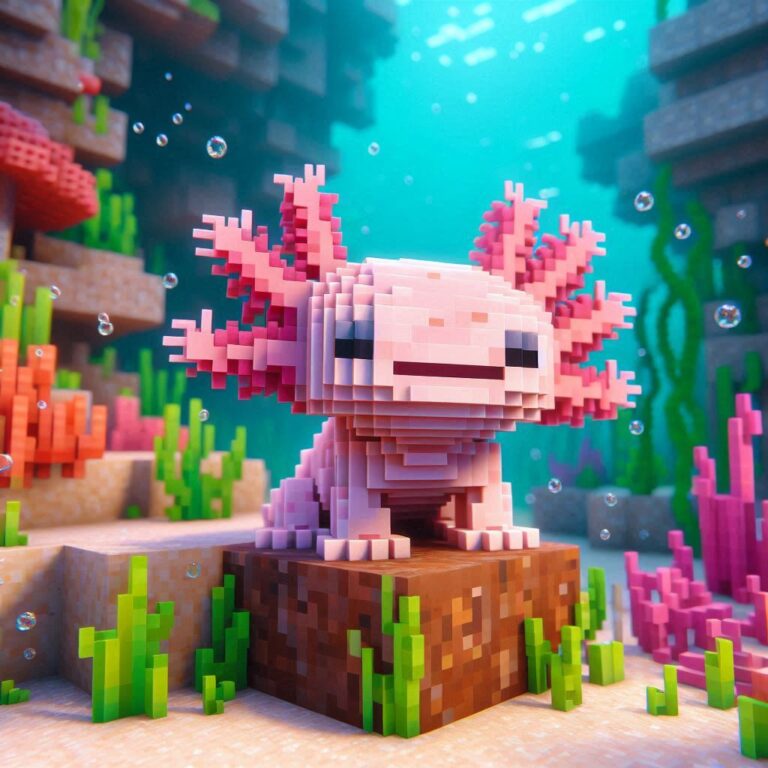
Axolotls and seahorses have vastly different habitat requirements and behaviors, making it generally inadvisable to house them together. Axolotls are amphibians native to freshwater habitats, requiring cooler temperatures and ample floor space in their tanks. They are carnivorous and may inadvertently harm smaller tankmates due to their feeding behavior. On the other hand, seahorses are marine fish that thrive in tall tanks with plenty of vertical space to hitch onto. They prefer warmer water temperatures and have specific dietary needs. Attempting to cohabitate these species could result in stress, injury, or even disease transmission, making it best to provide separate environments tailored to the unique needs of each species.
Habitat Requirements: Axolotls vs. Seahorses
Axolotls and seahorses hail from vastly different ecosystems, each with its own unique habitat requirements. Axolotls, native to the freshwater bodies of Mexico, thrive in environments with cool temperatures and ample hiding spots. Their habitats are often rich in vegetation and feature soft substrates like sand or gravel. These curious amphibians rely on their keen senses to navigate their surroundings, utilizing their gills to extract oxygen from the water. In contrast, seahorses are inhabitants of the world’s oceans, favoring coral reefs, seagrass beds, and estuaries. Their habitats provide a diverse array of structures for them to anchor onto using their prehensile tails. Seahorses are adapted to blend seamlessly into their surroundings, employing camouflage to evade predators. Understanding the distinct habitat requirements of both species is crucial for creating suitable environments in captivity, ensuring their health and well-being.
Tank Size and Setup
When it comes to housing axolotls and seahorses, tank size and setup play pivotal roles in their overall comfort and health. Axolotls, being relatively large amphibians, require spacious tanks with ample floor space to roam and explore. A tank capacity of at least 20 gallons per axolotl is recommended to accommodate their size and activity level. Additionally, providing plenty of hiding spots and aquatic plants mimics their natural habitat, reducing stress and promoting natural behaviors. On the other hand, seahorses thrive in taller tanks with vertical structures to hitch onto. A tank height of at least 18 inches allows seahorses to exhibit their characteristic vertical posture, mimicking their natural behavior in the wild. Careful consideration of tank dimensions and layout is essential to creating environments that cater to the specific needs of both species, promoting their overall well-being in captivity.
Temperature Preferences
Temperature regulation is critical for maintaining the health and vitality of axolotls and seahorses in captivity. Axolotls, being ectothermic amphibians, rely on external sources to regulate their body temperature. They prefer cooler water temperatures ranging from 16 to 18 degrees Celsius (60 to 64 degrees Fahrenheit). Extreme fluctuations in temperature can stress axolotls and compromise their immune systems, making precise temperature control essential. In contrast, seahorses are cold-blooded marine fish that thrive in warmer waters, with optimal temperatures ranging from 22 to 25 degrees Celsius (72 to 77 degrees Fahrenheit). Providing a reliable heating system and monitoring water temperatures closely ensures that both species remain comfortable and healthy in their respective environments.
Filtration Needs
Maintaining pristine water quality is paramount for the health and well-being of axolotls and seahorses in captivity, making proper filtration systems indispensable. Axolotls are notorious for producing copious amounts of waste, necessitating robust filtration systems to remove debris and maintain water clarity. A combination of mechanical, biological, and chemical filtration helps to keep ammonia and nitrate levels in check, preventing water contamination and potential health issues. Additionally, gentle water flow is crucial for axolotls, as strong currents can stress them and impede their movement. Similarly, seahorses are sensitive to water quality and require efficient filtration systems to ensure optimal conditions in their tanks. However, unlike axolotls, seahorses prefer gentle water flow to mimic their natural habitats and prevent exhaustion. Implementing appropriate filtration systems tailored to the specific needs of both species promotes a healthy aquatic environment, supporting their long-term well-being in captivity.
Seahorse Behavior: How It Affects Axolotls
Understanding the behavior of seahorses is crucial when considering housing them with axolotls. Seahorses are known for their unique characteristics, including their upright swimming posture, prehensile tails, and intricate courtship rituals. This behavior can have both positive and negative implications for axolotls sharing the same tank. On one hand, seahorses’ gentle movements and slow swimming patterns may not pose a direct threat to axolotls, potentially reducing the risk of aggressive interactions. However, their delicate nature and tendency to stay in one area of the tank may impact the axolotls’ natural exploration and foraging behaviors. Additionally, seahorses’ specialized feeding habits and dietary preferences may require careful consideration to ensure both species receive adequate nutrition without competition or conflict. By observing and understanding seahorses’ behavior, aquarists can better assess the compatibility of housing them with axolotls and implement appropriate measures to promote harmonious cohabitation.
Swimming Patterns
Seahorses exhibit unique swimming patterns characterized by their upright posture and slow, deliberate movements. Unlike most fish, seahorses lack a caudal fin and propel themselves using a small dorsal fin located on their back. This distinctive swimming style allows them to maneuver with precision and grace, often clinging to vertical structures using their prehensile tails. When housed with axolotls, seahorses’ swimming patterns may influence the overall dynamics of the tank. Their slow movements and tendency to remain in one area can create opportunities for interaction or observation by the axolotls. However, it’s essential to monitor their interactions closely to ensure that seahorses are not stressed or harassed by more active tankmates. Providing ample vertical structures and hiding spots allows seahorses to exhibit their natural behaviors while minimizing potential conflicts with axolotls.
Feeding Habits
Seahorses have unique feeding habits that differ from those of most fish. Due to their lack of teeth and small mouths, they rely on suction to draw in their prey, primarily small crustaceans and zooplankton. This specialized feeding method requires frequent feeding sessions to ensure adequate nutrition and energy levels. When housed with axolotls, seahorses’ feeding habits may impact the overall feeding regimen in the tank. Axolotls, being opportunistic carnivores, may compete with seahorses for food if not provided with separate feeding areas or appropriately sized prey items. Additionally, seahorses’ slow feeding process may require patience and careful observation to ensure that they receive their share of food without interference from more active tankmates. By understanding the unique feeding habits of seahorses, aquarists can develop feeding strategies that cater to the dietary needs of both species while minimizing competition and stress.
Social Interactions
Seahorses exhibit fascinating social behaviors, including courtship rituals, pair bonding, and hierarchical structures within groups. These social interactions play a crucial role in their reproductive success and overall well-being. When housed with axolotls, seahorses’ social behaviors may influence the dynamics of the tank environment. Pair bonding and territorial behaviors among seahorses could impact the distribution of resources and space within the tank, potentially leading to conflicts with other tankmates like axolotls. Additionally, seahorses may exhibit stress or aggression if their social needs are not met or if they feel threatened by more active or aggressive tankmates. Providing ample hiding spots and vertical structures allows seahorses to establish territories and seek refuge when needed, promoting a more harmonious social environment in the tank. By considering the social behaviors of seahorses, aquarists can create tank setups that accommodate their natural instincts while minimizing potential conflicts with other species like axolotls.
Dietary Differences Between Axolotls and Seahorses
Axolotls and seahorses exhibit distinct dietary preferences and feeding behaviors, stemming from their evolutionary adaptations and natural habitats. Axolotls are carnivorous amphibians with voracious appetites, primarily consuming live prey such as small fish, insects, worms, and crustaceans. Their diet is rich in protein and essential nutrients necessary for growth, development, and overall health. In contrast, seahorses are specialized feeders that primarily consume live prey, including small crustaceans, copepods, and amphipods. Their unique feeding mechanism involves using suction to draw in their prey, as they lack teeth and a protruding jaw. Seahorses have specific dietary requirements tailored to their unique physiology and digestive system. Understanding these dietary differences is crucial when planning the feeding regimen for both species in a shared tank environment, ensuring that each receives the appropriate nutrition without competition or conflict.
Feeding Frequency
Feeding frequency plays a crucial role in maintaining the health and vitality of axolotls and seahorses in captivity. Axolotls are opportunistic feeders known for their voracious appetites, often consuming prey items whenever available. However, overfeeding can lead to obesity and other health issues, making it essential to establish a regular feeding schedule. Typically, adult axolotls are fed 2-3 times per week, while juveniles may require more frequent feedings to support their rapid growth and development. Seahorses, on the other hand, have slower metabolisms and may require more frequent, smaller meals throughout the day to meet their nutritional needs. Feeding seahorses 2-3 times daily with small, frequent meals helps to prevent digestive issues and ensures that they receive an adequate supply of food. By tailoring the feeding frequency to the specific needs of each species, aquarists can promote optimal health and well-being in their captive environments.
Food Types
Axolotls and seahorses have diverse dietary preferences, requiring a variety of food types to meet their nutritional needs. Axolotls thrive on a diet of live prey, including bloodworms, blackworms, earthworms, and small feeder fish. Additionally, commercial axolotl pellets and gel foods formulated specifically for amphibians can provide a balanced source of nutrition. It’s essential to offer a varied diet to axolotls to ensure that they receive all the essential nutrients they need to thrive.
Seahorses, on the other hand, primarily consume live prey such as brine shrimp, mysis shrimp, and copepods. These small crustaceans provide essential vitamins, minerals, and fatty acids necessary for seahorses’ health and vitality. Offering a diverse array of live foods and enriching their diet with vitamin supplements ensures that seahorses receive a balanced nutritional profile. By providing a variety of food types tailored to the dietary preferences of each species, aquarists can support their overall health and well-being in captivity.
Nutritional Needs
Meeting the nutritional needs of axolotls and seahorses is essential for promoting their health, growth, and longevity in captivity. Axolotls require a diet rich in protein, essential amino acids, and fats to support their rapid growth and metabolic demands. Live prey items such as bloodworms, earthworms, and small feeder fish provide a natural source of nutrition, while commercial axolotl pellets and gel foods offer a convenient alternative. Additionally, supplementing their diet with calcium and vitamin D3 helps to prevent metabolic bone disease and promote strong, healthy bones. Seahorses have specific nutritional requirements tailored to their unique physiology and feeding behaviors.
Their diet should consist primarily of live prey, including brine shrimp, mysis shrimp, and copepods, to ensure that they receive essential vitamins, minerals, and fatty acids. Providing vitamin supplements and enriching their diet with nutritious foods supports their overall health and well-being in captivity. By understanding the nutritional needs of both species and providing a balanced diet tailored to their requirements, aquarists can ensure that axolotls and seahorses thrive in their captive environments.
Potential Risks of Housing Axolotls and Seahorses Together
While the idea of housing axolotls and seahorses together may seem appealing, it comes with several potential risks that aquarists should carefully consider. These risks stem from the stark differences in the natural behaviors, habitat requirements, and dietary preferences of both species. One of the primary concerns is the potential for aggressive behavior between axolotls and seahorses, which can result in injury or stress to one or both species. Additionally, competition for food resources may arise, especially if both species have overlapping prey preferences or feeding habits. Another significant risk is the potential transmission of diseases or parasites between axolotls and seahorses, as they may be susceptible to different pathogens. Understanding and mitigating these potential risks are crucial for ensuring the health and well-being of both species in a shared tank environment.
Aggressive Behavior
Aggressive behavior can pose a significant risk when housing axolotls and seahorses together in the same tank. While axolotls are generally known for their peaceful demeanor, they may exhibit predatory behavior towards smaller tankmates, including seahorses. Axolotls have been observed to snap at or attempt to consume smaller fish or invertebrates, posing a direct threat to the safety of seahorses. Additionally, territorial aggression among axolotls may result in conflicts over space or resources within the tank. Understanding the potential for aggressive behavior and providing adequate hiding spots and separation between axolotls and seahorses can help minimize the risk of injury or stress to both species.
Competition for Food
Competition for food resources is another potential risk when housing axolotls and seahorses together. Both species have distinct dietary preferences and feeding behaviors, which may lead to conflicts over limited food supplies. Axolotls are voracious carnivores that consume live prey such as small fish, insects, and worms, while seahorses primarily feed on live crustaceans and zooplankton. If not carefully managed, competition for food may result in one species outcompeting the other or inadequate nutrition for both species. Providing separate feeding areas or implementing a feeding schedule that accommodates the dietary needs of both axolotls and seahorses can help mitigate this risk and ensure that both species receive adequate nutrition.
Disease Transmission
Disease transmission poses a significant risk when housing axolotls and seahorses together, as they may be susceptible to different pathogens or parasites. Axolotls are known to carry certain bacteria or fungi that may be harmful to seahorses, while seahorses may harbor parasites that could affect axolotls. Additionally, stress from overcrowding or incompatible tankmates may weaken the immune systems of both species, making them more susceptible to infections. Quarantining new additions to the tank and regularly monitoring water quality and the health of all tank inhabitants can help prevent the spread of diseases or parasites. Implementing proper hygiene practices and providing a stress-free environment are essential for minimizing the risk of disease transmission and promoting the overall health and well-being of both axolotls and seahorses.
Temperature and Water Quality Considerations

Maintaining optimal temperature and water quality is paramount for the health and well-being of axolotls and seahorses in a shared tank environment. Temperature fluctuations and poor water quality can stress or even harm these delicate creatures, making it essential to monitor and regulate these parameters closely. Factors such as filtration, water circulation, and regular water changes play crucial roles in maintaining stable water conditions. Additionally, understanding the specific temperature and water quality requirements of both axolotls and seahorses is essential for creating a suitable habitat that promotes their overall health and vitality.
Ideal Temperature Range
The ideal temperature range for axolotls and seahorses differs due to their distinct natural habitats and physiological adaptations. Axolotls are cold-blooded amphibians that prefer cooler water temperatures ranging from 16 to 18 degrees Celsius (60 to 64 degrees Fahrenheit). In contrast, seahorses are marine fish that thrive in slightly warmer waters, with optimal temperatures ranging from 22 to 25 degrees Celsius (72 to 77 degrees Fahrenheit). Maintaining water temperatures within these respective ranges is crucial for ensuring that both species remain comfortable and healthy in their shared tank environment. Utilizing aquarium heaters and thermometers allows aquarists to monitor and regulate water temperatures effectively, ensuring that they remain within the ideal range for axolotls and seahorses.
pH Levels
pH levels play a vital role in maintaining water quality and supporting the health of axolotls and seahorses. Axolotls prefer slightly acidic to neutral pH levels ranging from 6.5 to 7.5, reflecting the pH of their native freshwater habitats. Seahorses, on the other hand, thrive in slightly alkaline to neutral pH levels ranging from 7.5 to 8.5, reflecting the pH of seawater. Maintaining stable pH levels within these respective ranges is essential for ensuring that both species’ biological processes function optimally and that they are not subjected to unnecessary stress. Monitoring pH levels regularly using aquarium test kits and adjusting them as needed with pH buffers or water changes helps to maintain stable water conditions and promote the overall health and well-being of axolotls and seahorses.
Water Hardness
Water hardness, as measured by the concentration of dissolved minerals like calcium and magnesium, can impact the health and well-being of axolotls and seahorses in a shared tank environment. Axolotls typically prefer soft to moderately hard water with a carbonate hardness (KH) of 3 to 8 dKH and a general hardness (GH) of 5 to 20 dGH. In contrast, seahorses are more adaptable to a wide range of water hardness levels, although they may thrive in slightly harder water with a KH of 8 to 12 dKH and a GH of 10 to 20 dGH. Maintaining stable water hardness levels within these ranges is crucial for supporting the growth and development of axolotls and seahorses and preventing potential health issues related to mineral imbalances.
Using water conditioners or remineralization products can help adjust water hardness levels as needed, ensuring that both species receive the optimal mineral content for their respective needs.
FAQs
Q. Can Axolotls and Seahorses Share the Same Tank?
A. It’s generally not recommended to house axolotls and seahorses together as they have different habitat requirements and behaviors.
Q. What Size Tank Do I Need for Axolotls and Seahorses?
A. Axolotls require a larger tank with ample floor space, while seahorses prefer tall tanks with plenty of vertical space to hitch onto.
Q. Do Axolotls Eat Seahorses?
A. While axolotls are primarily carnivorous, they typically don’t prey on seahorses due to their size difference. However, there’s still a risk of accidental harm.
Q. Can Axolotls and Seahorses Live in Brackish Water?
A. Axolotls are strictly freshwater creatures, whereas some seahorse species prefer brackish or even full marine conditions. Mixing these environments can be harmful to one or both species.
Q. How Do I Ensure Water Quality for Both Axolotls and Seahorses?
A. Regular water testing and maintenance are essential. However, achieving the ideal parameters for both species simultaneously can be challenging.
Q. Are Axolotls Aggressive Towards Seahorses?
A. Axolotls are generally not aggressive towards other tankmates, but their feeding behavior can be a risk to smaller creatures like seahorses.
Q. Can Seahorses Outcompete Axolotls for Food?
A. Seahorses may consume smaller food items faster than axolotls, potentially leaving the axolotls underfed if not monitored closely during feeding.
Q. Do Axolotls and Seahorses Require Different Water Temperatures?
A. Yes, axolotls prefer cooler temperatures around 16-18°C (60-64°F), while seahorses thrive in warmer waters around 22-25°C (72-77°F).
Q. Can I Keep Axolotls and Seahorses Together Temporarily?
A. It’s not advisable to keep them together even temporarily due to the risk of stress, injury, or disease transmission.
Q. What Are Some Alternative Tankmates for Axolotls?
A. Peaceful, similarly sized fish or other aquatic creatures like snails or shrimp can be suitable tankmates for axolotls, provided they have compatible environmental needs.
Conclusion
In conclusion, while the idea of housing axolotls and seahorses together may seem intriguing, it’s essential to carefully consider the various factors involved to ensure the health and well-being of both species. From habitat requirements and feeding habits to temperature and water quality considerations, each aspect plays a crucial role in creating a harmonious and thriving tank environment. By understanding the unique characteristics and needs of axolotls and seahorses, aquarists can tailor their care practices to accommodate both species effectively. However, despite efforts to mitigate potential risks such as aggressive behavior, competition for food, and disease transmission, it’s important to recognize that housing axolotls and seahorses together may not always be feasible or advisable.

Hassan Shah carries over four years of hands-on expertise in caring for axolotls, guided by his cherished companion ‘Little Bruno,’ a thriving axolotl under his attentive care for three years.



